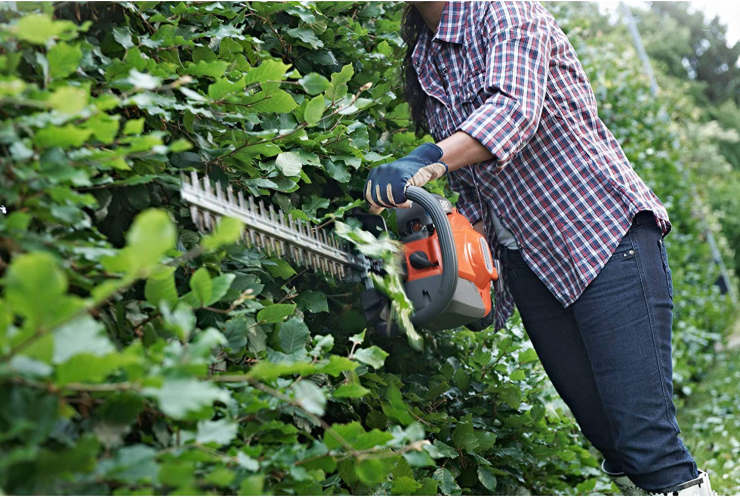Flowering Vines Most Suitable to Florida Climate
Warm and humid, Florida is the ideal climate for many types of flowering vines. Vines can add a pop of color, and many vines require very little care aside from occasional pruning. Any vines selected for Florida landscaping should thrive in high-humidity environments and be heat-tolerant.
The Best Flowering Vines to Grow in Florida
Jasmine
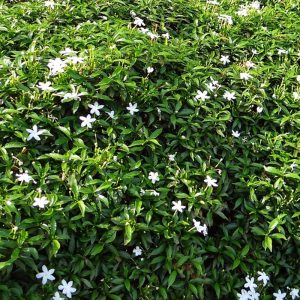
There are several varieties of jasmine, and many of them, including star jasmine and Carolina jasmine, are excellent options for Florida. White is the most common jasmine flower color, but some varieties have yellow flowers. These flowers produce a delightful, sweet aroma. Jasmine also produces broad, deep green leaves that work well to obstruct or soften walls or other outdoor features.
Jasmine is known as a hardy plant. It can be cut back or tied to trail in a certain direction. It’s best to prune jasmine plants right after they flower, which will create a fuller, healthier plant. Jasmine plants will generally require water about once per week, but in hotter climates such as Florida, more frequent watering may be needed. Acidic soil is the best option for jasmine plants, but if the soil isn’t acidic enough, coffee grounds can be added to offer the plant additional nutrients. Jasmine does well in either full or partial sun.
Morning Glory
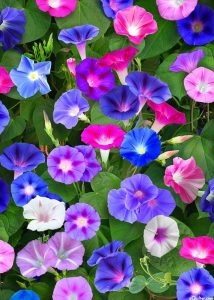
Morning glory flowers provide a bright pop of deep blue and vibrant purple color. Their large, broad leaves are also very attractive and create a shady, cool appearance. Morning glories are quite hardy, but the flowers only open in the morning, hence their name, and will close when the temperature becomes too hot.
Morning glory plants can grow to 15 ft. in height, and the vine will naturally stretch out. Morning glory plants don’t usually require pruning, but they can be gently trimmed if they grow too large, and dead foliage can be trimmed away in the spring. These hardy plants will need to be watered during dry periods but otherwise need little care. To encourage more blooms, old flowers can be pinched off. In warmer climates such as Florida, morning glories will return each year.
Mandevilla
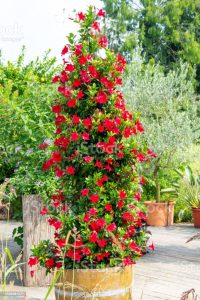
Lush, with large blooms, Mandevilla, also known as the rocktrumpet vine, is a striking statement vine for any garden, patio, or entryway. Mandevilla vines often produce red, pink, or white trumpet-shaped flowers.
Mandevilla vines are perennials, but they’re highly susceptible to cold temperatures and will wither at any temperatures 50 F or lower. This makes them an ideal choice for Florida, as they’ll thrive throughout the year. The leaves, however, are easily sunburned, so it’s best to offer Mandevilla vines some shade during the hottest parts of the day. Gardeners can pinch the ends of the vine off to create a fuller plant. These plants grow best in sandy soil that drains well and is high in nutrients. A fertilizer that is high in phosphorus can give these plants a boost.
Honeysuckle
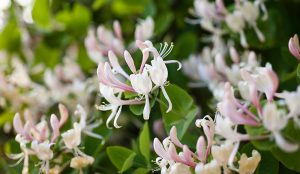
Known for its intoxicating smell honeysuckle is a wonderful addition to a Florida garden. Not only does it smell amazing, but this plant also produces gorgeous, delicate flowers. Different honeysuckle varieties have different flower colors, including white, yellow, pink, red, or peach. The flowers grow in clusters, and the colors pop against the plant’s small, deep green leaves.
Different honeysuckle varieties offer different landscaping opportunities. For example, some varieties are more prone to climbing, while others can act as a shrub or ground cover. Some have a shrub-like base but will produce delicate tendrils that can be trained to climb a fence or wall. Honeysuckle tends to prefer full sun, and it thrives in warm climates. These plants can take to a variety of soil types, and they also work well when grown in containers.
As honeysuckle grows, it often shades the bottom portion of the plant. Because it’s no longer receiving sunlight, the bottom can become sparse and woody. Thinning the top of the plant or ensuring the bottom receives adequate light can stop this from happening.
Rangoon Creeper
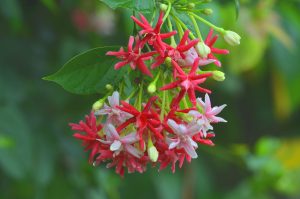
Quick to grow and with a full, bushy appearance, the Rangoon creeper is a stunning addition to a tropical garden. These plants feature small, star-shaped flowers that grow in clusters. The flowers are initially pink in color but turn a darker red as they mature.
Rangoon creepers prefer full sun and require frequent watering. Although they need a bit more care than some of the other plants on this list, Rangoon creepers will reward gardeners by spreading rapidly. Because the plant can spread so much, it’s important to give it plenty of space, and frequent pruning may be necessary if it becomes too large. These plants are not picky about the soil they’re grown in, as long as it’s well-draining and offers plenty of nutrients. To keep the plant flowering, be sure to offer two to three applications of fertilizer each year.
Sky Vine
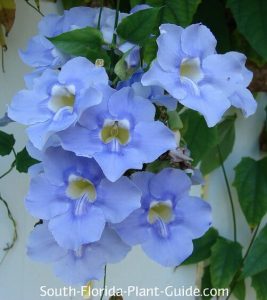
Sky vine has light green leaves and delicate light blue or pale violet flowers. The flowers resemble morning glories in shape, but they’re slightly smaller and have a softer color and appearance. Also known as clock vine, this flowering vine is one of the most popular in Florida because of its beauty and tolerance for a variety of landscapes.
Sky vines grow best in full sunlight, but they do not withstand heat well. For this reason, when growing them in Florida, it’s best to offer them some shade during the hottest parts of the day. Sky vines should be watered regularly but should be planted in well-draining soil. Fertilizing twice a year will deliver all of the nutrients the plant needs.
Sky vines can sometimes be difficult to find in commercial nurseries. Many people prefer to grow them from seed, which is quite effective, as the young plants are hardy.
Trumpet Vine
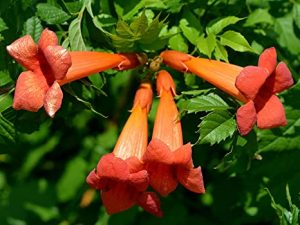
Named for the shape of their flowers, trumpet vines make a bold landscaping statement. These plants have dark leaves that contrast with the orange, peach, yellow, or red flowers. One of the easiest vines, and possibly one of the easiest plants, to care for, trumpet vines are said to actually prefer poor conditions. They thrive in a variety of soil conditions and require very little, if any, care.
To keep a trumpet vine in ideal shape, however, plant the vine in well-draining soil. These plants can tolerate full or partial sun, but blooms are more plentiful in full sun. Trumpet vines should only be watered when necessary, and they should not be fertilized. These plants grow rapidly and can expand outward, stretching their vines in all directions, very quickly. Pruning is often necessary to keep the plant in check.
Cross Vine
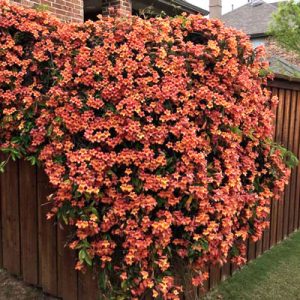
One of the boldest and most colorful vines that can thrive in Florida’s warm conditions, the cross vine sports beautiful red and yellow flowers. The flowers begin blooming in the spring and will last throughout summer, and they often attract butterflies and hummingbirds. The leaves of the cross vine are deep green and elongated, and the plant stays green throughout the year. This makes it an excellent option for concealing a wall or fence, and the leaves make the bright flowers stand out.
Cross vine, also sometimes spelled as crossvine, does best in full or partial sun. It prefers soil that stays moist but drains well. The more sun the plant gets, the more flowers it will produce. During cold temperatures, some of the vine’s leaves will turn red and fall away, which can be beautiful. However, this is unlikely to occur in most of Florida. The plant requires only occasional pruning to ensure it stays in check and grows where you want it.
Passion Vine
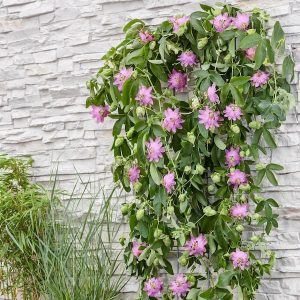
Passion vines sport some of the most unique flowers. Each flower is dark purple in the center and has numerous long, thin petals that extend outwards. The petals are usually paler than the center of the flower. Passion vine is a true climbing vine, and it will readily twine into and around a trellis, wall, or fence.
Passion vines don’t require much care, and they should only be watered once or twice each week. A thorough soaking is best. These plants do best in full sun.
Pandora Vine
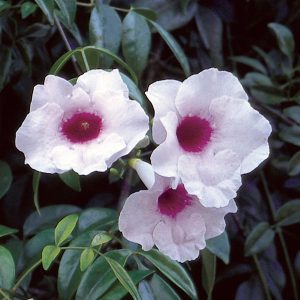
Pandora vine, also called bower vine, is a fast-growing plant that produces large, white flowers with red or purple centers. In warm climates, these plants bloom continuously throughout the year. The vine grows so rapidly that it can easily reach 15 ft. in height within just one or two growing seasons.
Pandora vines can handle droughts well, but they do best with frequent watering. It’s a good idea to let the soil dry out at the top before watering the plant again. The plant prefers full sun, but it should not be planted in a windy area.
Florida Flame
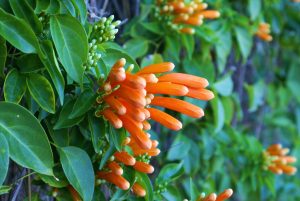
Florida flame produces small orange flowers that grow in clusters. The plant’s deep green leaves complement the flowers, and butterflies, bees, and hummingbirds are often attracted to the plant.
Florida flame plants grow very quickly, but you can prune them to grow wherever you like. It’s best to prune in late spring or early summer, as soon as the flowers have passed. The plant will respond well to frequent watering, as long as the soil does not become soggy. It’s also a good idea to fertilize the plant a couple of times each year, usually in the spring or fall.
Bougainvillea
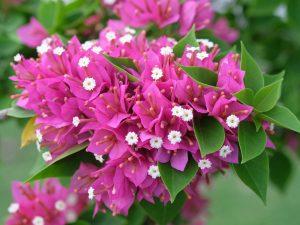
Bougainvillea plants are popular throughout the southern United States, and they’re a particularly fantastic addition to Florida landscaping. These plants produce delicate, papery red, white, pink, and purple flowers. In the right conditions, the plants flower throughout the year. The color of the blooms will be much bolder when the plant receives more sun.
Bougainvillea plants are susceptible to root rot, so it’s important to place them in soil that drains and doesn’t hold on to too much water. They should be watered three or four times each week, and it’s best to thoroughly soak the soil. The more water the plant receives, the greener the foliage will be, but it may produce fewer flowers.
Bleeding Heart Vine
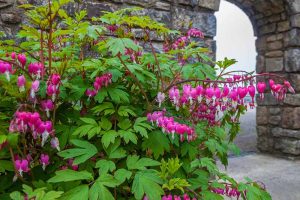
Bleeding heart vines provide striking flowers and dark, large leaves. The dense foliage sets off the brilliant white and red of these heart-shaped flowers, which are popular with butterflies. The flowers generally bloom in clusters.
Bleeding heart vines prefer full sun and will produce more flowers when grown in these conditions. These plants thrive in moist soil, so it’s important to water them frequently, especially during dry weather. However, it’s essential that the soil does not collect water, as this can lead to root rot. Bleeding heart vines should be planted where they will have some shelter from the wind.
Allamanda Vine
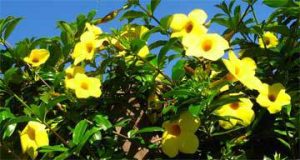
Allamanda vines have gorgeous, bright yellow, trumpet-shaped flowers that stand out against the plant’s small, arrow-shaped leaves. The flowers can be as large as 4 in. across. These plants do especially well in southern Florida, but they can be grown throughout the state. It is important to note that Allamanda vines are toxic, so plant them in areas away from pets or small children.
Allamanda vines prefer moist soil that drains well. When watering, completely soak the soil, and then wait until the top of the soil has dried out before watering again. Fertilize the plant every two or three weeks throughout the spring and summer to encourage more blooms. These vines will grow readily in either the ground or a container. The trailing branches do not twine, so they’ll need to be trained up a trellis or wall, or left to act as a vibrant groundcover.


